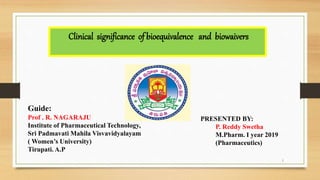
Clinical significance of bioequivalence and biowaivers
- 1. 1 Clinical significance of bioequivalence and biowaivers PRESENTED BY: P. Reddy Swetha M.Pharm. I year 2019 (Pharmaceutics) Guide: Prof . R. NAGARAJU Institute of Pharmaceutical Technology, Sri Padmavati Mahila Visvavidyalayam ( Women’s University) Tirupati. A.P
- 2. 2 contents Introduction Clinical significance of B E studies What is Biowaivers? Applicationsof Biowaivers Limitationsof Biowaivers Conclusion References
- 3. 3 introduction Bioequivalence Definition : “It is relative term which denotes that the drug substance in two or more identical dosage forms, reaches the circulation at the same relative rate & to same relative extent i.e., their plasma concentration time profiles will be identical without significant statistical differences”.
- 4. 4 Clinical significance of bioequivalence studies Bioequivalence of different formulations of the same drug substance involves equivalence with respect to the rate and extent of systemic absorption. Generally two formulations whose rate and extent of absorption differ by 20% or less are considered bioequivalent. An equivalent clinical response should be obtained from the comparision dosage form if the plasma drug concentration remain above MEC for appropriate interval and don’t reach the MTC.
- 5. 5 Reasons for bioequivalence study To prove that Generic Drug Products are bioequivalent to innovators/marketed drug product (Reference Listed Drugs). Change in formulations i.e., from capsule to tablets. To determine the efficacy and safety from the bioequivalence data.
- 6. 6 Bioequivalence studies are conductedif there is: A risk of bio- in- equivalence and/or. A risk of pharmacotherapeutics failure or diminished clinical safe . In vivo bioequivalence studies and in vitro dissolution testing recommended to applicants intending to submit (INDs) ,(NDAs) &(ANDAs) for conventional and extended release dosage forms administered orally.
- 7. 7 Biowaivers The term biowaiver is applied to a regulatory drug approval process when the dossier(application) is approved based on evidence of equivalence other than through in vivo equivalence testing. A biowaiver has been regarded as an official approval of the waiver for conducting a bioequivalence study and to boost the drug development process.
- 8. 8
- 9. 9 No biowaiver for: Locally applied, systemically acting products. Non- oral immediate release forms with systemic action. Modified release products. Transdermal products.
- 10. 10 REQUIREMENTS FOR A BIOWAIVER STUDY include regulatory authorities like FDA and WHO. a) Dissolution Test in 3 different media which are: Buffer pH 1.2, simulated gastric fluid (SGF) without enzymes or 0.1N HCl . Buffer pH 4.5, 6.8 or simulated intestinal fluid (SIF) without enzymes, all in 900 ml and at 37°C .
- 11. 11 b) 12 samples in each media, paddle rotating at 50 rpm or basket at 100 rpm . c) Sampling times are 10, 15, 20, 30, 45 and 60 minutes. d) The profiles of the test and reference products must be similar in all three media. e) The products are similar if the similarity factor f2 ≥ 50 and both products show ≥ 85% dissolution in 15 min
- 12. 12 APPLICATIONSOF BCS IN BIOWAIVER OF DRUG . Biowaiver means to obtain waive off for carrying out expensiveand time-consuming BA and BE studies. BCS provides biowaiver for Class I, II and III drug with some specifications. The USFDA BCS guidance recommends for biowaiver if the drug substance is highly soluble and highly permeable (Classdrugs) or an immediate release drug product.
- 13. 13 Limitation of BCS BCS based biowaiver are not applicable for the following: i. Narrow therapeutic range drug products. ii. BCS based biowaivers have limited application for the class II drugs and not applicable for class III.
- 14. 14 iii. Dosage form meant for absorption in the oral cavity e.g. sublingual or buccal tablets. iv. Effects of food, absorptive transporters, efflux transporters, and routes of elimination (renal/biliary) were important determinants ofoverall drug absorption and bioavailability for immediate release oral dosage forms, which are not considered in BCS.
- 15. 15 conclusion Bioequivalence studies are performed to compare the bioavailability of the generic drug product to the brand name product. Granting biowaivers under systems such as the BCS, eliminates unnecessary drug exposures to healthy subjects & provides economic relief, while maintaing the high public health standard for therapeutic equivalence.
- 16. 16
